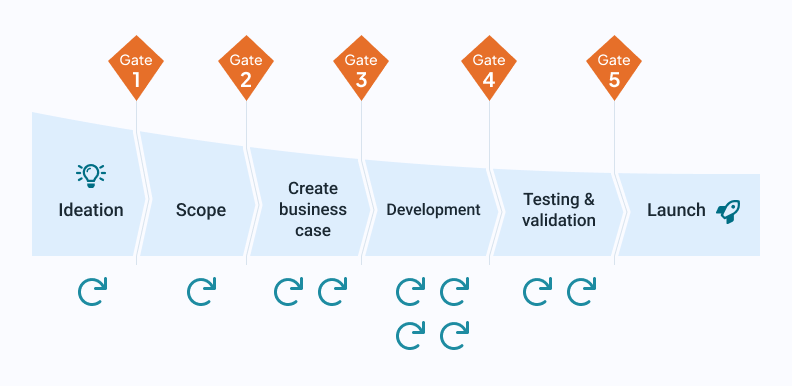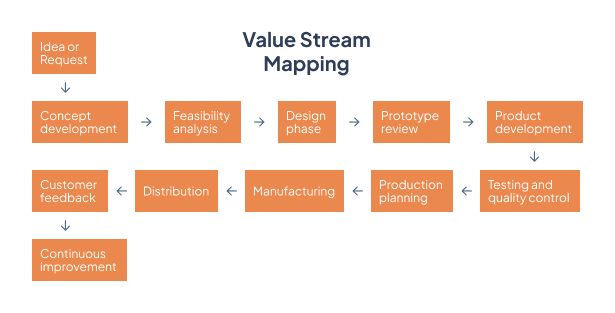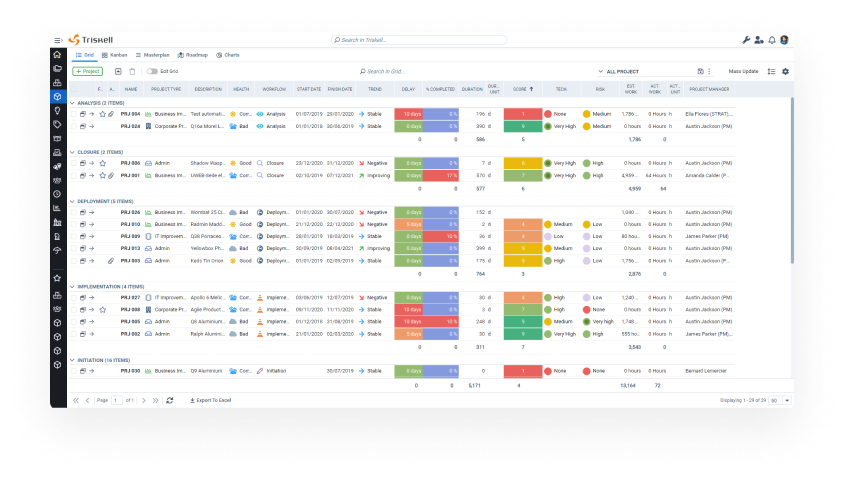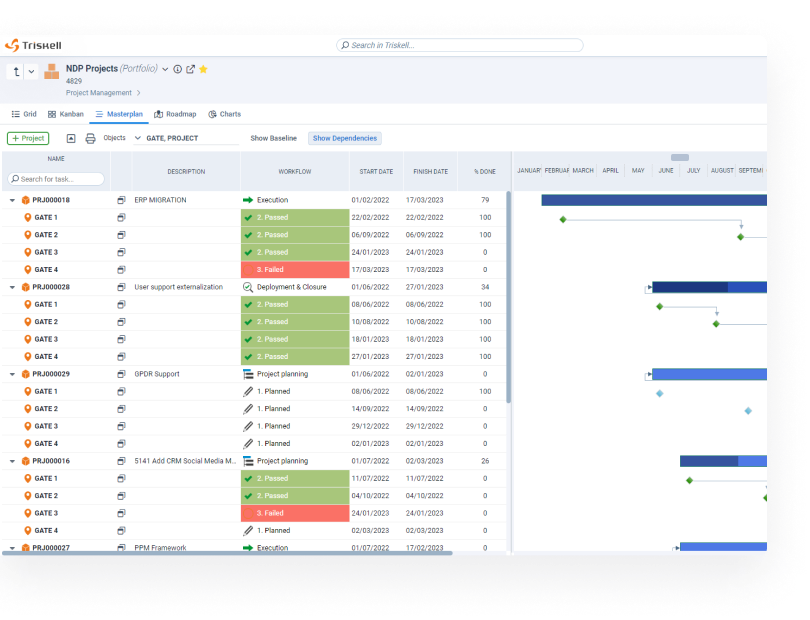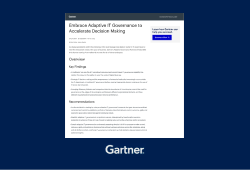10 product development trends for 2025

In the competitive environment of product development, anticipating and adapting to emerging trends is essential. This article explores the 10 most relevant Trends in Product Development for 2025, providing a detailed analysis of the various currents that are shaping the New Product Development and R&D landscape.
From hybrid approaches to innovative technologies, we aim to provide strategic guidance for both business leaders and development teams to dive into the future of successful product development and business innovation.
1. Agile Phase Gate, the product development trend you need
The main product development trend for 2025 is embracing hybrid approaches. More and more product development teams are adopting agile methodologies because of the flexibility they bring to the process and the responsiveness they provide to market fluctuations or changing customer requirements. However, they lack a structured framework that provides control and visibility.

NEW PRODUCT DEVELOPMENT
Make your New Product Development processes more efficient
Learn more about Triskell Software´s New Product Development solution.
This hybrid approach is particularly valuable in projects where complexity and risks require a delicate balance between flexibility and control. Imagine a software development project where customer requirements may evolve during the process. Agile Phase Gate would allow the addition of these changes without sacrificing the structure or integrity of the project, while ensuring that each phase is successfully completed before moving on to the next gate.
Since both management approaches have their drawbacks, why not integrate the best of both into a single hybrid approach? Agile Phase Gate enables adaptability and agile response to change while maintaining the sequential set of phases so distinctive of the Phase-Gate process. These checkpoints, or “Gates”, not only ensure the quality of the product under development, but also provide a clear view of progress and enable informed decisions to be made at every stage of the project.
2. User-centric mindset
The second product development trend is adopting a user-centric mindset. This goes beyond simply collecting user feedback in satisfaction surveys or on social media. It is a philosophy of doing things that reshapes the way organizations conceive, design and deliver products.
Users are the ones who determine the success or failure of a product or service. It is no longer a matter of promoting initiatives that satisfy their needs, but of knowing in depth their experiences, emotions and expectations.
- How do users feel when interacting with the product?
- What are their unspoken desires?
- How does the product integrate into their daily lives?
To answer these and other questions, you must implement real-time data analytics strategies to understand user interactions with every aspect of the product. From navigating an application to using specific functions, every interaction becomes a valuable data point that feeds the continuous improvement cycle.
But user-centric culture is not just limited to product development and design teams. It is a cultural shift that drives collaboration and consistency across all user touchpoints. For example, when marketing teams understand the narratives that resonate with users and the customer support team anticipates their questions and concerns, it creates a cohesive ecosystem that boosts user loyalty.
SUBSCRIBE TO OUR NEWSLETTER
Get stories like this in your inbox
3. The power of data and BI
Data analytics is transforming the way organizations interpret, apply and capitalize on information generated throughout the product lifecycle. It is a strategic resource that drives informed decisions. And, in this context, Business Intelligence (BI) becomes the catalyst that transforms seemingly disparate data into coherent and actionable information. The applications of data intelligence in the context of product development are endless:
- Analyze behavioral patterns.
- Detect trends.
- Forecast product performance in the market.
Implementing machine learning algorithms and predictive analytics enables organizations to not only react to changes but to anticipate them, providing a significant competitive advantage. Organizations should not collect data for the sake of it, but to make strategic decisions about their product portfolios. For example:
- Streamline operations and processes for improved efficiency.
- Make changes to product design based on user feedback.
- Adjust the marketing strategy in real time.
4. IoT is still booming
IoT has become a driving force that permeates every corner of product development, from consumer devices to advanced industrial solutions. With connected devices generating real-time data, the possibilities for customization and continuous improvement are limitless.
In fact, the Internet of Things is shaping the evolution of many industries, for example:
- Manufacturing: thanks to connected machinery, smart production lines and real-time monitoring systems, companies are optimizing efficiency and reducing costs.
- Health: devices such as wearable health monitors or sensors embedded in medical devices enable continuous monitoring of patients’ health.
- Retail: thanks to IoT sensors, Retail companies can collect data on customer behavior, enabling more personalized Marketing strategies or the optimization of store design.
- Automotive: IoT plays a crucial role in connected vehicles, enabling functions such as real-time navigation, predictive maintenance and vehicle-to-vehicle communication.
But as more devices join the Internet of Things ecosystem, enterprises face new security and data privacy challenges. This is where organizations must be proactive in implementing procedures to ensure data protection and network security in an increasingly connected world.
Get the full potential of your product development teams
Request a demo and discover how Triskell can be tailored to address the challenges and needs of your R&D initiatives.
5. Adopting a product improvement mindset
Product development is not a linear process with a clearly defined beginning and end. It is a continuous cycle where the launch of a product does not mark the end of its evolution, but the beginning of a phase of constant refinement and improvement. Product Managers and Product Owners, therefore, should not perceive perfection as a state achieved, but as an ever-expanding horizon to pursue.
Therefore, continuous improvement should be a strategic philosophy in your organization, and it has several areas of application:
- Data analytics: user analytics, product performance metrics and customer feedback are essential to your decision-making for product enhancements. It’s not just about solving problems you detect, but also identifying opportunities for refinement and growth based on tangible, real-time data.
- Continuous learning: each version and iteration of the product are lessons and learnings that are accumulated in the organization’s knowledge base. Knowledge that should be used not only to avoid past mistakes but also to identify patterns of success and areas of potential innovation.
- Agile methodologies: Agility is key in the adoption of this mindset. The ability to implement rapid changes and make frequent updates becomes essential. Agile software development methods, such as Scrum or DevOps, are particularly compatible with this mindset, as they allow short development cycles and an agile response to market needs.
Each version, each iteration, is a valuable lesson that contributes to the organization’s accumulated knowledge
6. Digital design reduces costs and increases efficiency
Digital design is not just the final step before production; it is an intrinsic partner throughout the entire product lifecycle, from the early conceptualization stages to continuous optimization after launch. Its integration throughout the product development process enables:
- Increased agility.
- Improved responsiveness to market changes.
- Early detection of problems, with consequent cost savings.
Digital design and prototyping tools are playing an increasingly important role in the whole process. Leading organizations are not only using design software to create visual representations of products. They are leveraging technologies such as virtual and augmented reality to create interactive prototypes and immersive experiences. This not only speeds up the design process but also provides a deeper understanding of product usability and performance before production begins.
Digital design also plays a key role in cross-team collaboration. Creating digital prototypes accessible through cloud platforms facilitates the participation of key stakeholders, from designers and developers to marketing representatives and end users. This early and continuous collaboration not only improves the quality of the final product, but also reduces the need for significant adjustments later in the process, saving time and resources.
Each version, each iteration, is a valuable lesson that contributes to the organization’s accumulated knowledge
What’s more, the use of cloud solutions also allows teams to simulate real-world scenarios, from product behavior in various situations to performance in specific environments. This not only reduces the need for costly physical testing, but also allows for more accurate and efficient optimization.
7. AI streamlines tasks and processes
The strategic integration of AI into the product lifecycle is radically reshaping the way we conceive, execute and improve products, triggering a paradigm shift in operational efficiency. And the fact is that, thanks to AI, not only will you be able to automate many of the routine tasks of your product teams, but its scope of application goes far beyond that. Here are just a few examples:
- Optimization of decision-making processes: With AI systems you can analyze large data sets to provide valuable insights for product development, from identifying market trends to assessing potential risks. This not only improves the quality of decisions, but also accelerates the strategic decision-making process.
- Product personalization: AI enables the creation of highly customized products, from tailoring the user interface to recommending specific features based on user behavior. This not only improves the user experience, but can also drive customer loyalty and differentiate a product in a saturated market.
- Identification of patterns and trends: By analyzing large amounts of data, AI can foresee potential problems, identify areas for improvement and anticipate market demands. This not only speeds up the detection of potential problems, but also enables a proactive response before they become significant obstacles.
SUBSCRIBE TO OUR NEWSLETTER
Get stories like this in your inbox
In short, AI is revolutionizing the way we conceive and execute processes in product development. Those organizations that recognize AI as a strategic ally are not just automating tasks; they are building the infrastructure for continuous innovation and operational efficiency in the digital age.
8. Focus on value streams
Product Development cannot be conceived as a series of phases isolated from each other, but as a process in which interdependencies and synergies are everywhere. Value streams represent the set of activities that transform ideas into products and deliver them to end users. Understanding and continuously improving value streams is necessary to deliver maximum value to customers and the business.
To understand value streams in detail, it is necessary to constantly evaluate processes to identify bottlenecks, redundancies, and areas for improvement. Implementing PPM tools with process analysis capabilities and real-time data collection will give you full visibility into every phase of development. This transparency will not only improve decision-making but also allows for quick and strategic adjustments.
The focus on value streams also implies a culture of continuous improvement. Agile frameworks, especially Lean and DevOps, or the Kaizen cycle, themselves provide the ideal framework for the implementation of feedback loops and continuous improvement, thus creating a seamless and continuous value supply chain.
9. Data-driven decision making
Organizations no longer rely solely on intuition or experience; they use systematically collected data to inform and support strategic decisions. This not only improves the quality of decisions but also enables a faster and more agile response to changes in the business environment.
Data-driven decision-making extends to the entire product lifecycle. From idea conception to customer delivery and market feedback, data is a constant companion. User analytics, performance metrics and customer feedback become fundamental building blocks that guide product customization and each phase of development.
Data-driven decision making extends to the entire product lifecycle
It is particularly interesting to see how efficient data analytics processes can benefit product customization. By analyzing data on user behavior, preferences and interactions, organizations can tailor products and services more precisely to individual customer needs.
But, for data-driven decision making to be efficient, it is essential to address the quality and integrity of the data collected. Organizations must invest in robust data management practices and the implementation of measures to ensure privacy and information security.
10. Use a PPM solution to integrate all NPD processes in a single tool
As you can see, product development involves an interconnected network of processes, projects and resources. And more and more organizations are choosing to integrate all New Product Development processes into a single PPM platform. These tools not only simplify management, but also provide a comprehensive, real-time view of all activities related to product development.
These are some of the benefits your organization will gain by acquiring a PPM software for Product Development:
- Workflow integration: you can create customizable workflows that adapt to the structure and specific needs of the organization. From idea conception to product delivery, each phase of development is seamlessly integrated, eliminating gaps and redundancies that can arise in environments where processes operate in isolation.
- Centralization of information: PPM solutions serve as a centralized repository. This not only facilitates access to relevant information for all teams, but also improves data quality by reducing errors and duplication.
- Efficient resource management: these tools provide visibility into team workload, resource availability and delivery schedules. This enables more accurate allocation and strategic resource planning.
- Real-time risk management: with a PPM tool, not only will you be able to identify potential risks in real time, but you will also have the tools to mitigate them. The ability to assess the impact of risks on product portfolios allows you to make informed and proactive decisions to minimize potential mishaps.
In addition, it should be noted that PPM solutions not only focus on project execution, but also allow managing the entire product lifecycle, from conception to retirement. This ensures consistency and continuity in product and project management, eliminating silos and improving efficiency.
Conclusion: Move your business forward with these Product Development Trends
To sum up 2025 product development trends, here are the main elements to remember. Product development is shaped by a hybrid approach that is user-centric, data-driven and enabled by emerging technologies. Proactive adoption of these trends will not only ensure competitiveness but will also lay the foundation for continued excellence in product development.
Staying at the forefront of these currents will be the key to not only surviving in the marketplace, but thriving and leading innovation in the years to come.
SUBSCRIBE TO OUR NEWSLETTER
Get stories like this in your inbox
Request a demo of Triskell Software
Want to know how Triskell Software can help you to manage your organization’s R&D projects? Check it out for yourself and request a Triskell demo now.
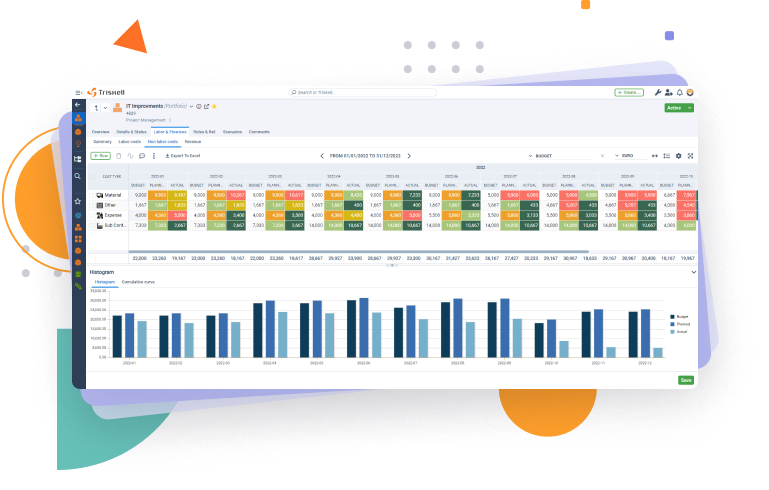
FAQs about Product Development trends
What are the advantages of adopting an Agile Phase-Gate approach?
The Agile Phase-Gate approach is a rising star in “Product development trends” for 2025. It merges the best aspects of two popular methodologies:
- Agile: Provides flexibility, faster iteration cycles, and a focus on continuous improvement.
- Phase-Gate: Offers a structured approach with clear decision points and risk management processes.
By combining these elements, Agile Phase-Gate offers several advantages:
- Increased control with agility: Maintains a structured development process with defined stages and go/no-go decisions at each phase, providing control over resource allocation and risk management. However, it allows for flexibility within stages through iterative development cycles.
- Improved responsiveness to change: Agile practices like continuous feedback loops enable adjustments based on market changes or user insights.
- Enhanced decision-making: Phase-gates with clear criteria for project progression ensure informed decisions based on data and progress evaluation.
- Reduced risk: Regular reviews and go/no-go decisions at phase gates help identify and mitigate potential problems early on, minimizing wasted resources.
How can companies ensure a user-centric mindset throughout the product development process?
Cultivating a user-centric approach is a crucial “Product development trend”. Here are some ways to achieve this:
- Integrate user research early and often: Conduct user research activities like surveys, interviews, and usability testing at various stages of development.
- Involve users in the development process: Consider user feedback loops throughout the development cycle. Invite users to participate in beta testing and gather their insights on prototypes or early versions of the product.
- Emphasize user personas: Create detailed user personas that represent your target audience. Refer to these personas throughout development to ensure features and functionalities cater to user needs.
- Align product goals with user needs: Ensure your product roadmap and development decisions prioritize solving user problems and delivering value to your target audience.
How can businesses leverage data and Business Intelligence (BI) for successful product development?
Data and BI are playing an increasingly important role in “Product development trends”. Here’s how businesses can leverage them:
- Inform product decisions: Analyze market data, competitor analysis, and customer demographics to understand market needs and identify potential opportunities.
- Optimize features: Use data from A/B testing and user behavior analytics to determine which features resonate with users and optimize product functionality.
- Track product performance: Utilize data analytics to monitor key performance indicators (KPIs) like user engagement, conversion rates, and customer satisfaction. This helps identify areas for improvement and measure the product’s overall success.
- Predict future trends: Leverage data analysis to forecast future market trends and user behavior patterns, allowing for proactive product development strategies.
What are the benefits of using a Project Portfolio Management (PPM) solution to streamline product development processes?
- Improved resource management: PPM tools provide a centralized platform to allocate resources effectively, track team workload, and avoid conflicts.
- Enhanced project visibility: Gain real-time insights into project progress, identify potential roadblocks, and ensure all development activities are on track.
- Streamlined communication and collaboration: PPM tools facilitate communication and collaboration among team members and stakeholders, ensuring everyone is aligned and working towards the same goals.
- Data-driven decision making: PPM solutions offer reporting and analytics capabilities, enabling data-driven decisions throughout the development lifecycle.
By implementing a PPM solution, companies can achieve greater efficiency, improve project delivery, and ultimately develop successful products that meet market demands.
